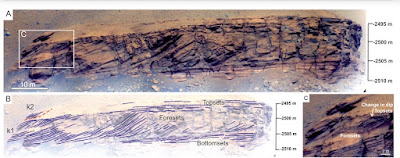From the past few days:
1) India is rapidly losing fossil rich outcrops to urbanization, expanding agriculture, mining, and unregulated fossil collection.
On International Fossil Day, October 23, 2021, the Paleontological Society of India, Pune Mumbai Student Chapter, organized a very informative online symposium on this topic. I have linked to part of the talks held that day. Paleontologist Dr. Rajani Panchang was the moderator. Several young researchers describe their field work in Kutch, Tamil Nadu, and Spiti Valley. Over the past several years, changes in land use and unchecked fossil removal has resulted in outcrop degradation and impoverishment.
.Video Permanent Link - India Fossil Outcrops .
Even though the Geological Survey of India and some local agencies have identified locations of geological importance, at present India does not have a law for the preservation of geoheritage sites. D.M. Banerjee writes about the struggle to get the Indian government to take up this issue seriously in his article Fate of Indian Geoheritage and Geopark Bill, published in the July 2021 issue of Current Science.
2) The origin of domestic horses has been a tough case to crack. It was long held using archeological evidence that horses were domesticated by the Botai Culture in Central Asia around 3500 B.C. But ancient DNA studies indicated that these early domesticated lines are not the ancestors of the modern domestic horse. Instead, the origin of the modern domestic horses have been tracked to the Volga-Don region in the Western Eurasian steppes between 2500 and 2000 B.C. The abstract of the paper is worth reading through-
Domestication of horses fundamentally transformed long-range mobility and warfare. However, modern domesticated breeds do not descend from the earliest domestic horse lineage associated with archaeological evidence of bridling, milking and corralling at Botai, Central Asia around 3500 bc. Other longstanding candidate regions for horse domestication, such as Iberia and Anatolia, have also recently been challenged. Thus, the genetic, geographic and temporal origins of modern domestic horses have remained unknown. Here we pinpoint the Western Eurasian steppes, especially the lower Volga-Don region, as the homeland of modern domestic horses. Furthermore, we map the population changes accompanying domestication from 273 ancient horse genomes. This reveals that modern domestic horses ultimately replaced almost all other local populations as they expanded rapidly across Eurasia from about 2000 bc, synchronously with equestrian material culture, including Sintashta spoke-wheeled chariots. We find that equestrianism involved strong selection for critical locomotor and behavioural adaptations at the GSDMC and ZFPM1 genes. Our results reject the commonly held association between horseback riding and the massive expansion of Yamnaya steppe pastoralists into Europe around 3000 bc driving the spread of Indo-European languages. This contrasts with the scenario in Asia where Indo-Iranian languages, chariots and horses spread together, following the early second millennium bc Sintashta culture.
The paper is open access. And there is an easier to understand article in Nature as well.
3) The remarkable range of technologies brought to bear on understanding the geology of Mars is giving some spectacular payoffs. Two studies caught my eye:
a) Mars' surface shaped by fast and furious floods from overflowing craters: Lake breach floods produced fast flowing streams that cut deep drainage valleys, reshaping the Mars landscape. Catastrophism has played a large role in the history of Martian surface evolution.
b) The Perseverance Rover rocks on!! The stunning images it has taken of rock outcrops on Mars is enabling geologists to reconstruct details of ancient sedimentary environments. N. Mangold and colleagues describe a delta lake system and flood deposits at Jezero Crater.
Take a look at the details available to geologists for interpreting sedimentary processes and the rock history.
On Mars, large crater lakes were sites of sediment deposition. Rivers meeting such craters dumped their sediment on the crater floor in lobes that expanded lakewards forming a delta. The architecture of the sedimentary layers within this delta environment has been vividly captured and described in this study. In the image, the bottomset strata are fine grained sediment deposited in waters ahead of the delta. The foreset strata represent deposition on the inclined growing delta front. And the foreset strata are deposits of rivers associated with the delta. The paper is quite detailed and a treat for sedimentologists. But the images can be enjoyed by all. Open Access too!


No comments:
Post a Comment